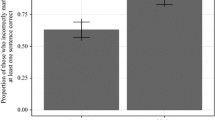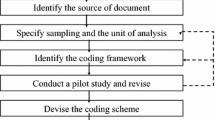Abstract
Business managers regularly employ metaphorical violent rhetoric as a means of motivating their employees to action. While it might be effective to this end, research on violent media suggests that violent rhetoric might have other, less desirable consequences. This study examines how the use of metaphorical violent rhetoric by business managers impacts the ethical decision making of employees. We develop and test a model that explains how the use of violent rhetoric impacts employees’ willingness to break ethical standards, depending on the source of the rhetoric. The results of two experiments suggest that the use of violent rhetoric by a CEO at a competing company increases employees’ willingness to engage in ethical violations while the use of violent rhetoric by employees’ own CEO decreases their willingness to engage in unethical behavior. Furthermore, we find that participants who made less ethical decisions motivated by violent rhetoric used by a competitor’s CEO did not view their decisions as less ethical than the other participants in the experiments. The results of these studies highlight potentially harmful unintended consequences of the use of violent rhetoric, providing knowledge that should be useful to managers and academics who want to increase employee motivation without increasing a willingness to engage in unethical behavior.


Similar content being viewed by others
Notes
It is important to note that the theory predicts there is a reasonable range, so in this example the theory applies to an otherwise “normal” manager who would be unlikely to make up a new accounting rule or otherwise commit more blatant ethical deviations to get the bonus.
Johnson et al. (2002) showed that exposure to more television (not violent television, but just television in general) was related with more aggressive behavior 17 years later.
AMT is a marketplace where individuals can hire other people to perform tasks online. Both workers and hirers sign up for the service. Hirers then post “hits” (job assignments) for workers to perform. Workers accept the “hit,” perform the work, and then are compensated if their work is deemed of sufficient quality by the hirer. As shown by Berinsky et al. (2012), AMT generally results in high quality responses that are relatively representative of large, random samples of US participants. We note for both studies, all participants gave their informed consent to participate and that the studies were approved by the appropriate Institutional Review Boards before being administered.
Although participants were randomly assigned to experimental conditions, there were significant differences in age and years of work experience across some experimental conditions. We therefore include these variables as covariates in all analyses. The results are qualitatively similar to those reported in all instances whether we include or exclude the covariates. Furthermore, these two variables do not interact with our experimental manipulations. We define qualitatively similar to mean the results are in the same statistical direction and of the same level of statistical significance (i.e., significant p < 0.05, marginally significant p < 0.10) as the reported results. Finally, we note that years of work experience is not significant in any of our models. Age is significant and results in participants being less likely to post a rating or a review (p < 0.10).
If we include participants who failed the manipulation check the results are qualitatively similar to those reported except in relation to employee’s willingness to issue a negative rating. We define qualitatively similar to mean the results are in the same statistical direction and of the same level of statistical significance (i.e., significant p < 0.05, marginally significant p < 0.10) as the reported results.
The question labels were for question 1, “1—Did not have moral/ethical implications” and “7—Did have moral/ethical implications;” for question 2, “1—Not serious” and “7—Very serious;” for question 3, “Very unlikely,” “Unlikely,” “Somewhat unlikely,” “Undecided,” “Somewhat likely,” “likely”, and “Very likely;” for question 4, “1—Very unfair” and “7—Very fair.”
We note that we use one-tailed (two-tailed) p-values when a (no) directional prediction is made by a hypothesis.
We found no randomization imbalances between conditions (all ps > 0.10)
We note that if we include participants who missed the manipulation check questions the results are qualitatively similar to those reported except that the willingness to accept a low credit score is significant at the p = 0.104 level. We define qualitatively similar to mean the results are in the same statistical direction and of the same level of statistical significance (i.e., significant p < 0.05, marginally significant p < 0.10) as the reported results.
References
Bandura, A., Barbaranelli, C., Caprara, G., & Pastorelli, C. (1996). Mechanisms of moral disengagement in the exercise of moral agency. Journal of Personality and Social Psychology, 71(2), 364–374.
Banerjee, D., Cronan, T. P., & Jones, T. W. (1998). Modeling IT ethics: A study in situational ethics. MIS Quarterly, 22(1), 31–60.
Bar-Tal, D., Raviv, A., Raviv, A., & Dgani-Hirsh, A. (2009). The influence of the Ethos of conflict on Israeli Jews’ interpretation of Jewish-Palestinian encounters. Journal of Conflict Resolution, 53(1), 94–118.
Bartholow, B. D., Anderson, C. A., Carnagey, N. L., & Benjamin, A. J. (2005). Interactive effects of life experience and situational cues on aggression: The weapons priming effect in hunters and nonhunters. Journal of Experimental Psychology, 41(1), 48–60.
Berinsky, A. J., Huber, G. A., & Lenz, G. S. (2012). Evaluating online labor markets for experimental research: Amazon.com’s mechanical turk. Political Analysis, 20(2), 1–18.
Bushman, B. J., Jamieson, P. E., Weitz, I., & Romer, D. (2013). Gun violence trends in movies. Pediatrics, 132(6), 1014–1018.
Committee of Sponsoring Organizations (COSO). (1992). Internal control—integrated framework. New York: COSO.
Committee of Sponsoring Organizations (COSO). (2004). Enterprise risk management—integrated framework. New York: COSO.
Darley, J. M., Klosson, E. C., & Zanna, M. P. (1978). Intentions and their contexts in the moral judgments of children and adults. Child Development, 49(1), 66–74.
Eagly, A. H., & Chaiken, S. (1993). The psychology of attitudes. Orlando: Harcourt Brace Jovanovich College Publishers.
Elmer-DeWitt, P. (2012). Apple wants Steve Jobs’ bio excluded from Samsung trial. CNN Money, Retrieved June 30, 2014 from http://tech.fortune.cnn.com/2012/05/01/apple-wants-steve-jobs-bio-excluded-from-samsung-trial/?iid=SF_F_River.
Gubler, J. R., and Kalmoe, N. P. (2013). Fighting words: The influence of violent rhetoric on intergroup aggression. Working Paper, Brigham Young University and George Washington University.
Herbert, B. (2002). Saturated with violence. The New York Times, Published October 28, 2002.
Hunton, J. E., Hoitash, R., & Thibodeau, J. C. (2011). The relationship between perceived tone at the top and earnings quality. Contemporary Accounting Research, 28(4), 1190–1224.
Huston, A. C., Donnerstein, E., Fairchild, H., Feshbach, N. D., Katz, P. A., Murray, J. P., et al. (1992). Big world, small screen: The role of television in American society. Lincoln: University of Nebraska.
Isaac, M. (2012). Nokia, Microsoft build ‘beachhead’ in war of the mobiles. Wired, Retrieved June 30, 2014 from http://www.wired.com/gadgetlab/2012/01/nokia-microsoft-lumia/.
Johnson, J. G., Cohen, P., Smailes, E. M., Kasen, S., & Brook, J. S. (2002). Television viewing and aggressive behavior during adolescence and adulthood. Science, 295, 2468–2471.
Kalmoe, N. P. (2012). A call to arms: How ‘fighting’ words mobilize political participation with aggression. Working Paper, University of Michigan.
Kaplan, S. E., Samuels, J. A., & Thorne, L. (2009). Ethical norms of CFO insider trading. Journal of Accounting and Public Policy, 28(5), 386–400.
Landau, M. J., Meier, P. B., & Keefer, L. A. (2010). A metaphor-enriched social cognition. Psychological Bulletin, 136(6), 1045–1067.
Lightspeed Research, Inc. (2008). Three strikes and you’re out! Retrieved November 26, 2013 from http://www.lightspeedresearch.com/press-releases/three-strikes-and-you%E2%80%99re-out/.
Lightspeed Research, Inc. (2011). Consumers rely on online reviews and price comparisons to make purchase decisions. Retrieved November 26, 2013 from http://www.lightspeedresearch.com/press-releases/consumers-rely-on-online-reviews-and-price-comparisons-to-make-purchase-decisions/.
Mayer, D. M., Kuenzi, M., Greenbaum, R., Bardes, M., & Salvador, R. (2009). How low does ethical leadership flow? Test of a trickle-down model. Organizational Behavior and Human Decision Processes, 108(1), 1–13.
Mazar, N., Amir, O., & Ariely, D. (2008). The dishonesty of honest people: A theory of self-concept maintenance. Journal of Marketing Research, 45(6), 633–644.
McCabe, D. L. (1992). The influence of situational ethics on cheating among college students. Sociological Inquiry, 62(3), 365–374.
Neilsen, S. L. (1972). Intergroup conflict and violence, Belfast 1968. Psychosocial Studies, 4 (University of Bergen, Norway).
Online Hosting Network. (2012). Scandalous businesses attempt to scare and confuse Online Hosting Network customers! Retrieved June 30, 2014 from http://onlinehostingnetwork.com/truth-online-hosting-network.php.
Ottati, V., Rhoads, S., & Graesser, A. C. (1999). The effect of metaphor in processing style in a persuasion task: A motivational resonance model. Journal of Personality and Social Psychology, 77, 688–697.
Parents Television Council. (2007). Dying to entertain: Violence on prime time broadcast television, 1998 to 2006.
Parrish, R. (2011). MacKeeper says ‘unethical competitor trying to tarnish our reputation.’ Applegazette. Retrieved June 30, 2014 from http://www.applegazette.com/feature/exclusive-mackeeper-says-unethical-competitor-trying-to-tarnish-our-reputation/.
Petty, R. E., & Cacioppo, J. T. (1986). Communication and persuasion: Central and peripheral routes to attitude change. New York: Springer-Verlag.
Pickerd, J., Summers, S. L., and Wood, D. A. (2014). An examination of how entry-level staff auditors respond to tone at the top vis-à-vis tone at the bottom. Working Paper, University of Massachusetts-Amherst, Brigham Young University, and Brigham Young University.
Rawwas, M. Y. A., Patzer, G. L., & Vitell, S. J. (1998). A cross-cultural investigation of the ethical values of consumers: The potential effect of war and civil disruption. Journal of Business Ethics, 17, 435–448.
Rawwas, M. Y. A., Vitell, S. J., & Al-Khatib, J. A. (1994). Consumer ethics: The possible effects of terrorism and war on the ethical values of consumers. Journal of Business Ethics, 13, 223–231.
Schaubroeck, J. M., Avolio, B. J., Lord, R. G., Dimotakis, N., Hannah, S. T., Kozlowski, S. W. J., et al. (2012). Embedding ethical leadership within and across organization levels. Academy of Management Journal, 55(5), 1053–1078.
Shu, L. L., Gino F., & Bazerman M. H. (2011). Dishonest deed, clear conscience: When cheating leads to moral disengagement and motivated forgetting. Personality and Social Psychology Bulletin, 37(3), 330–349.
Singer, M. S. (1996). The role of Moral intensity and fairness perception in judgments of ethicality: A comparison of managerial professionals and the general public. Journal of Business Ethics, 15(4), 469–474.
Sopory, P., & Dillard, J. P. (2006). The persuasive effects of metaphor: A meta-analysis. Human Communication Research, 28(3), 382–419.
Tenbrunsel, A. E., & Messick D. M. (2004). Ethical fading: The role of self-deception in unethical behavior. Social Justice Research, 17(2), 223–236.
Trevino, L. K. (1986). Ethical decision making in organizations: A person-situation interactionist model. The Academy of Management Review, 11(3), 601–617.
Author information
Authors and Affiliations
Corresponding author
Additional information
We are grateful for helpful comments from the anonymous reviewers, Scott Emett, Noah Myers, Jeffrey Pickerd, Jessica Preece, Kyle Shields, and Dan Stephens.
Rights and permissions
About this article
Cite this article
Gubler, J.R., Kalmoe, N.P. & Wood, D.A. Them’s Fightin’ Words: The Effects of Violent Rhetoric on Ethical Decision Making in Business. J Bus Ethics 130, 705–716 (2015). https://doi.org/10.1007/s10551-014-2256-y
Received:
Accepted:
Published:
Issue Date:
DOI: https://doi.org/10.1007/s10551-014-2256-y




